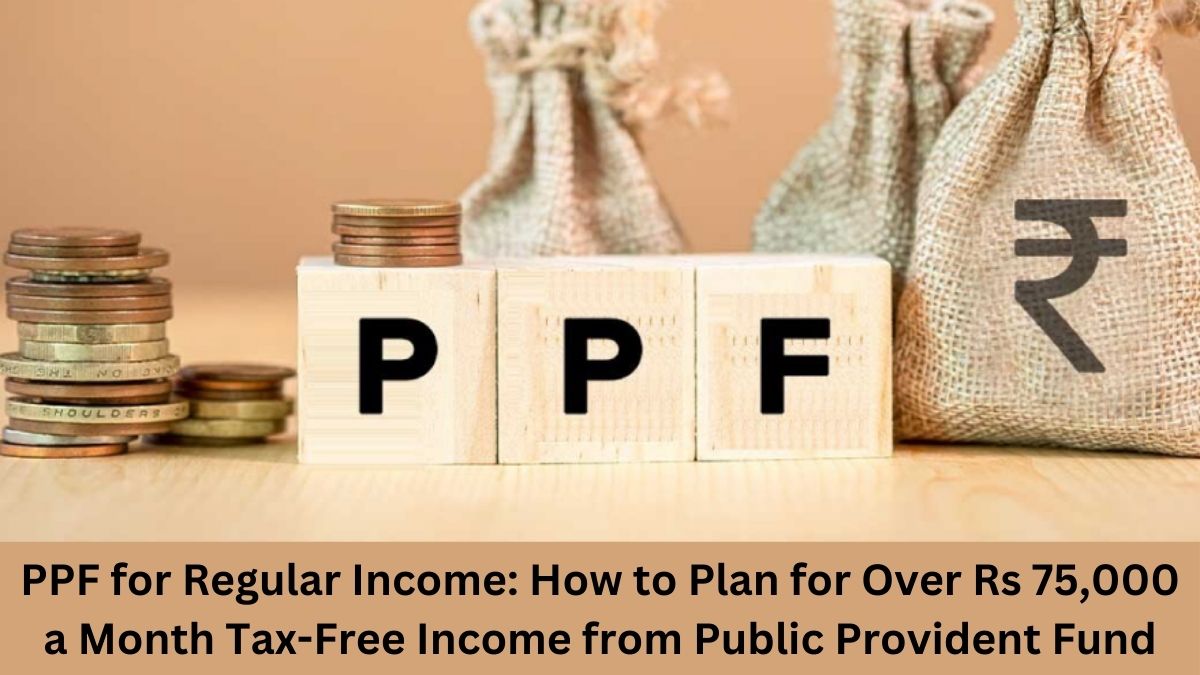The Public Provident Fund (PPF) has long been a favorite investment option for risk-averse individuals seeking tax-free returns, compounded growth, and financial security. While traditionally considered a long-term savings vehicle, PPF can also be strategically utilized to generate a steady, tax-free monthly income of over Rs 75,000 after maturity. This article delves into the nuances of PPF and explores how to leverage it effectively for a substantial tax-free monthly income.

Understanding the Public Provident Fund (PPF)
The PPF is a government-backed savings scheme that offers attractive tax benefits under Section 80C of the Income Tax Act. It is designed to encourage individuals to save regularly while reaping the benefits of tax-free compound interest.
Key Features of PPF:
- Tenure: The initial tenure is 15 years, extendable in blocks of 5 years.
- Investment Limit: A minimum of Rs 500 and a maximum of Rs 1.5 lakh per year.
- Interest Rate: Revised quarterly, the current rate (as of January 2025) is 7.1% per annum.
- Tax-Free Returns: Both the principal and interest earned are exempt from tax.
- Liquidity: Partial withdrawals and loans against the PPF balance are allowed after a specific period.
While the 15-year lock-in period may appear limiting, the PPF’s compounding power and tax-free growth make it an excellent vehicle for building a corpus that can provide regular income.
The Strategy: Building a Corpus for Regular Income
The key to generating a monthly income of Rs 75,000 or more lies in disciplined, long-term investment in the PPF. Here’s how you can plan effectively:
1. Maximize Annual Contributions
- Invest the maximum allowable amount of Rs 1.5 lakh every financial year. This ensures you benefit from the full compounding potential of the PPF and maximize your tax savings under Section 80C.
- Early contributions in the financial year (ideally in April) allow the invested amount to accrue interest for the entire year, further boosting your returns.
2. Leverage the 15-Year Tenure
- The PPF’s 15-year tenure may seem lengthy, but it provides a substantial window for compounding. With consistent investments and reinvestment of interest, the corpus grows exponentially.
- For instance, investing Rs 1.5 lakh annually for 15 years at an average interest rate of 7.1% can yield a maturity value of approximately Rs 40.7 lakh.
3. Extend the Tenure
- Once the initial 15 years are completed, you can extend the tenure in blocks of 5 years, with or without additional contributions. This is where the real magic happens.
- Continuing contributions during the extension periods significantly boosts the corpus, as the compounded interest grows tax-free.
4. Plan for Withdrawals
- After maturity, you can withdraw funds annually or in lumpsum while leaving the remaining amount to earn interest.
- The strategic withdrawal of interest while keeping the principal intact ensures a steady, tax-free income stream.
Calculating the Corpus for Rs 75,000 Monthly Income
To achieve a monthly income of Rs 75,000, you need a PPF corpus of approximately Rs 1.26 crore (assuming an annual interest rate of 7.1%). Here’s the breakdown:
- At 7.1% annual interest, the monthly interest on Rs 1.26 crore is around Rs 75,000, which can be withdrawn tax-free.
- Building this corpus requires disciplined contributions and a focus on extending the PPF tenure beyond the initial 15 years.
Illustration:
- Initial 15 Years: Contribute Rs 1.5 lakh annually for 15 years. Assuming a steady interest rate of 7.1%, the corpus grows to around Rs 40.7 lakh.
- First 5-Year Extension: Continue contributing Rs 1.5 lakh annually. The corpus grows to approximately Rs 70 lakh.
- Second 5-Year Extension: Maintain the same contribution pattern. By the end of the 25th year, the corpus can reach Rs 1.26 crore or more, depending on the prevailing interest rates.
Benefits of Using PPF for Regular Income
- Tax-Free Returns: The interest and withdrawals from the PPF are entirely exempt from income tax, providing a significant advantage over taxable investment options.
- Guaranteed Returns: Backed by the government, PPF offers assured returns, making it an attractive option for risk-averse investors.
- Financial Discipline: The mandatory lock-in period and annual contribution limits encourage consistent savings habits.
- Liquidity Post-Maturity: Post-maturity withdrawals and partial access to the corpus ensure flexibility while retaining the benefits of compounding.
Alternative Scenarios and Flexibility
The PPF also offers flexibility to adapt to different financial goals:
- Partial Withdrawals for Emergencies:
- After the 7th year, partial withdrawals are allowed, which can be helpful for unforeseen expenses.
- Loans Against PPF:
- Up to 25% of the balance can be borrowed between the 3rd and 6th years, offering liquidity without breaking the investment.
- Without Further Contributions:
- If you stop contributing after maturity, the corpus continues to earn interest, ensuring steady growth.
Tips to Optimize Your PPF Strategy
- Start Early: The earlier you begin investing, the greater the power of compounding. Starting in your 20s or 30s can yield a much larger corpus compared to starting later in life.
- Consider Family Accounts: Open PPF accounts for family members (spouse or children) to multiply your tax-saving and compounding benefits.
- Monitor Interest Rates: Stay informed about PPF interest rate revisions and align your strategy to maximize returns.
- Avoid Premature Withdrawals: Withdrawing funds prematurely disrupts compounding and delays your income goal.
Comparing PPF with Other Income-Generating Investments
While PPF is an excellent tax-free option, it’s essential to evaluate it against other income-generating avenues:
| Feature | PPF | Fixed Deposit | Mutual Funds (Debt) | Real Estate |
|---|---|---|---|---|
| Tax Benefits | Fully Tax-Free | Interest Taxable | Partially Tax-Free | Taxable (Rental Income) |
| Risk | Very Low | Low | Moderate | High |
| Liquidity | Limited Before Maturity | High | Moderate | Low |
| Returns | Moderate (7.1%) | Moderate (6-7%) | Varies (6-10%) | Varies (Rental Yield) |
PPF stands out for its combination of guaranteed returns, tax-free status, and long-term growth potential.
Conclusion
The Public Provident Fund is more than just a savings tool—it is a powerful vehicle for creating wealth and securing a tax-free, regular income. By starting early, maximizing contributions, and extending the tenure strategically, you can build a corpus capable of generating over Rs 75,000 per month. Combined with its safety and tax efficiency, PPF remains an unmatched choice for individuals seeking financial independence and a stress-free retirement.
By understanding and implementing this strategy, you can transform the humble PPF into a reliable source of substantial, tax-free income, ensuring long-term financial stability.
Click here to know more.
Kishan is an experienced writer with in-depth knowledge of exam preparation, government schemes, and government job updates. He specializes in creating well-researched and informative content on competitive exams, policies, and educational topics. His writing style is clear, concise, and easy to understand, making complex subjects accessible to readers.
